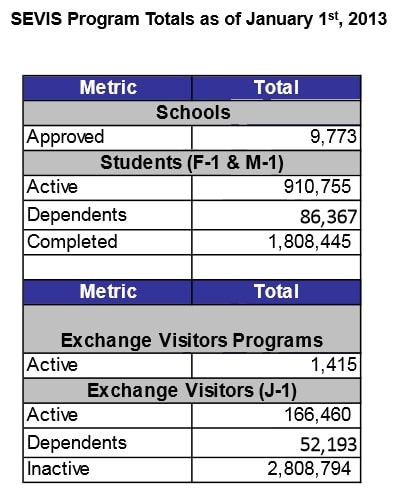US Department of Homeland Security school outreach programme works to eliminate fraud
The US government continually works to establish and strengthen professional relationships between academic institutions and local Homeland Security Investigations (HSI) offices in order to preserve the integrity of the international student visa programme, protect certified institutions against fraud and ensure national security. To learn more about how US schools can operate within compliance and proactively work with the government, we present an exclusive video interview with Mr Michael Compitiello from the US Department of Homeland Security (DHS). Watch our interview and continue reading below for more information on the activities of the DHS, such as their Campus Sentinel School Outreach initiative, as well as a new security change for border agents announced earlier this month.
US department structure and student statistics
The September 11th attacks prompted the US to create the DHS, Immigration and Customs Enforcement (ICE), and the Student and Exchange Visitor Program (SEVP). The departments' roles are, as outlined on the government website:
- The Department of State (DoS) manages exchange visitor programmes, non-immigrant exchange visitors in the J visa classification, and their dependents.
- Both SEVP and DoS use the Student and Exchange Visitor Information System (SEVIS) to track and monitor schools, exchange visitor programmes, and F, M and J non-immigrants while they visit the US and participate in the US education system."
The volume of data in SEVIS continues to grow. On 1 January 2013, SEVIS contained records for over 1 million active non-immigrant students, exchange visitors, and their dependents. The total number of records for all F-1, M-1, and J-1 visa holders has increased to approximately 10.3 million.
SEVIS monitoring
As Mr Compitiello explains, SEVP was put into place to monitor foreign students' progress and current location via the SEVIS electronic system:
"We found a loophole after 9/11... there was no comprehensive way to track students once in the US and the SEVIS programme was the answer to that problem."
Maintaining accurate and up-to-date SEVIS records is critical to ensure the safety of foreign students, prevent exploitation of the system, and continue to welcome legitimate international students via a healthy student visa programme. Mr Compitiello offers examples of some of the common pitfalls for schools, such as keeping student records up-to-date, specifically:
- enrolment status, especially if a student has completed his/her programme early or has transferred to a different school;
- a student's (and/or his/her dependent's) change of name or address;
- accurate programme start and end dates;
- Optional Practical Training (OPT) authorisation including employer and address;
- disciplinary action due to criminal conviction.
Ultimately, as Mr Compitiello affirms,
"It's a partnership between the government and the schools themselves."
The benefits of this collaboration are numerous, such as:
- by sharing information with school officials, the DHS may help improve a school's programme management and help prevent students from falling out of status;
- information sharing and open lines of communication between the DHS, institutions, and students works to improve strategies for identifying and prosecuting unlawful activity;
- investigating and eliminating fraudulent schools upholds the integrity of the student visa programme;
- teamwork improves the reputation of international education programmes in the United States, raises foreign student enrolment at quality schools, and reduces potential threats to national security.
US government partnership with school officials
In order to facilitate this partnership, the ICE Project Campus Sentinel School Outreach initiative was formed. The campus sentinel gives the DHS a chance to go out to the schools, meet with Designated School Officials (DSO), and personally educate them on how to avoid pitfalls. This face-to-face engagement opens the lines of communication, and shows them how to keep records up the date and report any suspicious activity. Institutions are encouraged to alert the DHS if they become aware of dubious activity, such as:
- non-SEVP certified institutions providing instruction to foreign students;
- failure to maintain accreditation, licensing, facilities, curriculum or necessary teaching staff;
- schools allowing students to drop below SEVP attendance requirements;
- sudden, high volume foreign student enrolment growth;
- unusually high patterns of schools transferring students in and out multiple times;
- schools unlawfully maintaining students' 'Active' status in exchange for money;
- recruitment of students under false pretenses or advertising of programmes that the school does not offer;
- schools manufacturing or providing false diplomas or transcripts.
Naturally, the majority of institutions have the best of intentions but as Mr Compitiello says, "One bad apple can spoil the bunch." Mr Compitiello concludes with one overriding message to our industry:
"We appreciate the business that the schools are doing - it helps our economy - and we are here to help you do business the right way and to avoid any problems that you may have because of a lack of having someone to ask."
SEVIS access for all border agents
Safety and compliance continues to be much on the minds of the public, especially in the wake of the Boston bombings. The tragedy spurred the government to initiate a new procedure - effective immediately.
The DHS ordered border agents to verify that every international student who arrives in the US has a valid student visa.
Under existing procedures, border agents could verify a student's status in SEVIS only when the person was referred to a second officer for additional inspection or questioning. Under the new procedures, all border agents are expected to be able to access SEVIS to verify a student's visa status before the person arrives in the US using information provided in flight manifests. If that information is unavailable, border agents will check the visa status manually with the agency's national targeting data centre. Regarding the information sharing and security challenges, Mr Michael McCaul, Chairman of the House Committee on Homeland Security, told CNN:
"The fact that a foreign national was able to re-enter the US with what appeared to be a valid student visa, while Customs and Border Protection (CBP) officers were unaware that his visa status had become invalid, represents a serious hole in our national security. The front-line CBP officers did not have access to the system that would have informed them of a change in legal status."
It is unclear what long term impact the new procedure will have on wait times at airports and borders, but in the immediate term, schools should alert incoming students to allow for more time at airports. Customs officials are required to report any effect, including longer waits, on a daily basis, and there have been reported delays of 30 minutes to three hours at major airports (i.e., in Los Angeles, Miami and San Francisco) due to F, J and M visa holders being sent to secondary inspection. Inside Higher Ed has reported that the impact is especially being felt by border commuter students.

















